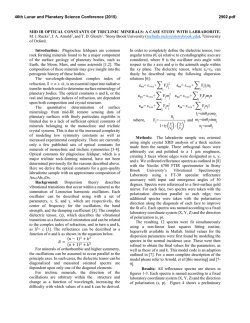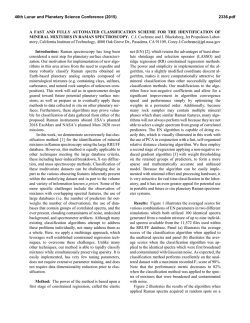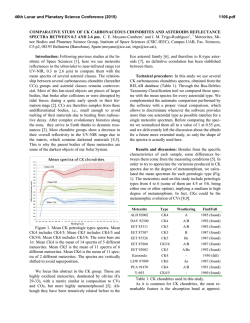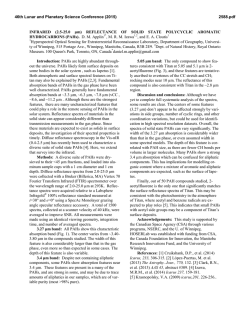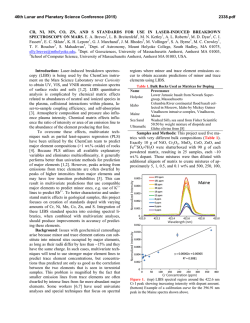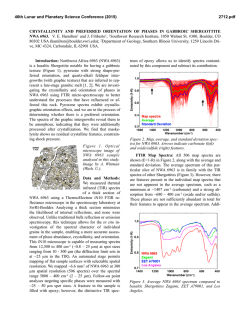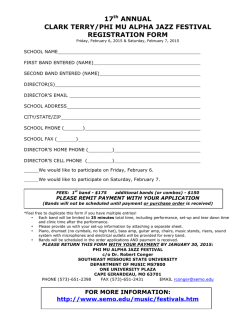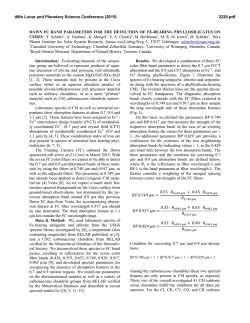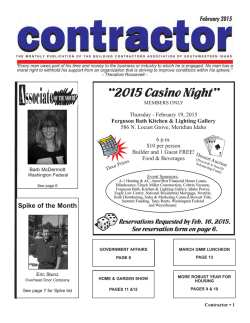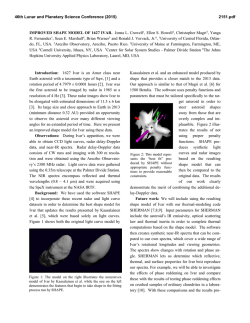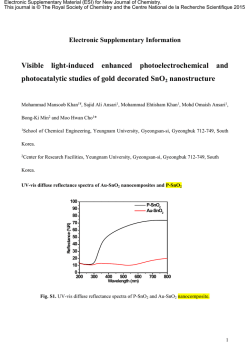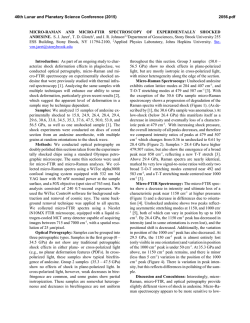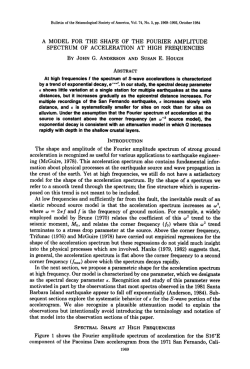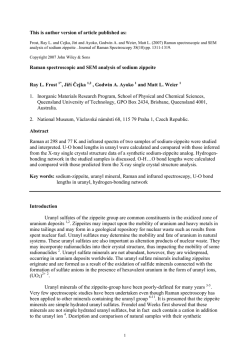
Coordinating Chemical and Mineralogical - USRA
46th Lunar and Planetary Science Conference (2015) 1537.pdf COORDINATING CHEMICAL AND MINERALOGICAL ANALYSES OF ANTARCTIC DRY VALLEY SEDIMENTS AS POTENTIAL ANALOGS FOR MARS S. N. Patel1,2, J. L. Bishop2, P. Englert3, and 4 1 E. K Gibson . San Jose State University (San Jose, CA; [email protected]). 2SETI Institute (Mountain View, 3 CA). University of Hawaii at Mānoa (Honolulu, HI). 4Johnson Space Center (Houston, TX). Introduction: The Antarctic Dry Valleys (ADV) provide a unique terrestrial analog for Martian surface processes as they are extremely cold and dry sedimentary environments. The surface geology and the chemical composition of the Dry Valleys that are similar to Mars suggest the possible presence of these soil formation processes on Mars. The soils and sediments from Wright Valley, Antarctica were investigated in this study to examine mineralogical and chemical changes along the surface layer in this region and as a function of depth. Surface samples collected near Prospect Mesa and Don Juan Pond of the ADV were analyzed using visible/nearinfrared (VNIR) and mid-IR reflectance spectroscopy and major and trace element abundances. Methods: Many samples were collected from soil pits and lakebottom depth profiles during 1979/1980. The sampling locations of two cores studied here are shown in Figure 1. VNIR spectra were measured of the sediment grains using an ASD spectrometer [1]. Bidirectional reflectance spectra were measured from 0.3-2.55 µm and FTIR reflectance spectra from 1-25 µm for crushed versions of the samples using the RELAB facility at Brown University as in previous experiments e.g. [2]. Other geochemical analysis methods including Na+, Ca2+ and Cl- were also carried out [3]. Results: Don Juan Pond - Core DJ39. The spectra of each sample contained a band near 1.89-1.93 µm due to combinations of H2O stretching and bending vibrations, as well as bands in the 2.1-2.4 µm region due to OH combination vibrations. Elevated hydration Figure 1. Map of Wright Valley (from [3]) and sampling locations for cores DJ39 and WV72. bands were found for samples collected 3-9 cm below the surface. Samples in this region exhibited spectral mineral fingerprints similar to those of clays and sulfates (Figure 2) suggesting elevated chemical alteration in this zone. These spectra exhibit bands near 1.45 and 1.94 µm and weak features near 1.76 and 2.24-2.26 µm that are consistent with the spectral features of gypsum [4]. Bands near 1.92 and 2.20 µm are characteristic of allophane [5]. Figure 2. Reflectance spectra of three samples from core DJ39 representative of the high salt/water region of the core are compared to spectra of gypsum (orange), allophane (red), and montmorillonite (light green). Figure 3. Photo of sample core aligned with a bar graph showing the elevated salt region. The arrows show the relationship between the chemistry and the thin layers of bright sediment. 46th Lunar and Planetary Science Conference (2015) 1537.pdf H2O soluble cation and anion abundances for Na+, and Cl- measured from a previous study [3] showed an elevated salt region of 3-8 cm below the surface (Figure 3). Similar patterns in 1.94 µm band depth due to H2O in minerals and salt abundance (Na+, Cl-) along the soil profile suggest that chemical alteration is occurring a few cm below the surface as opposed to at the surface. Ca2+ Wright Valley Soil Pit #1 - Core WV72. The chemical composition of these samples are shown in Table 1. Greater abundances of Cl-, NO3- and SO4- are observed a few cm below the surface and the presence of these ions decreases down the soil profile below ~20 cm. Spectra of many of the samples in core WV72 contain water bands near 1.45 and 1.94 µm, which indicate the presence of hydrated components. Spectra of sample JB1089 from 2-4 cm depth contain the strongest pair of bands at 2.44 and 2.55 µm. This doublet feature together with the water bands are consistent with the spectrum of Iron(III) Nitrate Nonahydrate or (Fe(NO3)3●H2O (Figure 4). Spectra of other forms of hydrated nitrates also exhibit doublet features near 2.42.6 µm, but are less consistent with the bands observed in the Wright Valley sediment spectra. Elevated NO3abundances were observed in samples from 2-16 cm depth in the sample core in preliminary anion extractions (Table 1). Table 1. Concentrations of various anions for each sample of Drive tube 72 (note that extraction of the ions may be incomplete). Figure 4. Reflectance spectrum of Wright Valley soil pit sample JB1089 (orange) compared to lab spectra of hydrated iron (III) nitrates. Summary and Applications to Mars: Increased abundances of soluble cations and anions were observed in sediments a few cm below the surface in a soil pit at Don Juan Pond. Spectra of these subsurface sediments have deeper water bands consistent with elevated amounts of hydrated sulfates, salts and clays. Increased soluble anion abundances were also observed for sediments 2-16 cm below the surface in a soil pit near Prospect Mesa. Spectra of some of these samples included a doublet related to the spectral features of hydrated iron nitrate. This study shows elevated abundances of hydrated minerals through their spectral features and elevated abundances of soluble cations a few cm below the surface. This is attributed to increased chemical activity just below the surface. References: [1] Patel S. (2013) NCUR Proceedings, 802-809. [2] Bishop J. L. et al. (2014a) Phil Trans Royal Soc. A, 372, 20140198. [3] Gibson E. K. et al. (1983) JGR, 88, A912-A928. [4] Bishop J. L. et al. (2014b) Am.Min., 99, 2105-2115. [5] Bishop J. L. et al. (2013) Clays Clay Min., 61, 57-74. Acknowledgements: We are grateful to the SETI InstituteSJSU URSA program that supported work by S. Patel on the project. Thanks are also due to T. Hiroi for acquiring the spectra at RELAB/Brown Univ.
© Copyright 2026
